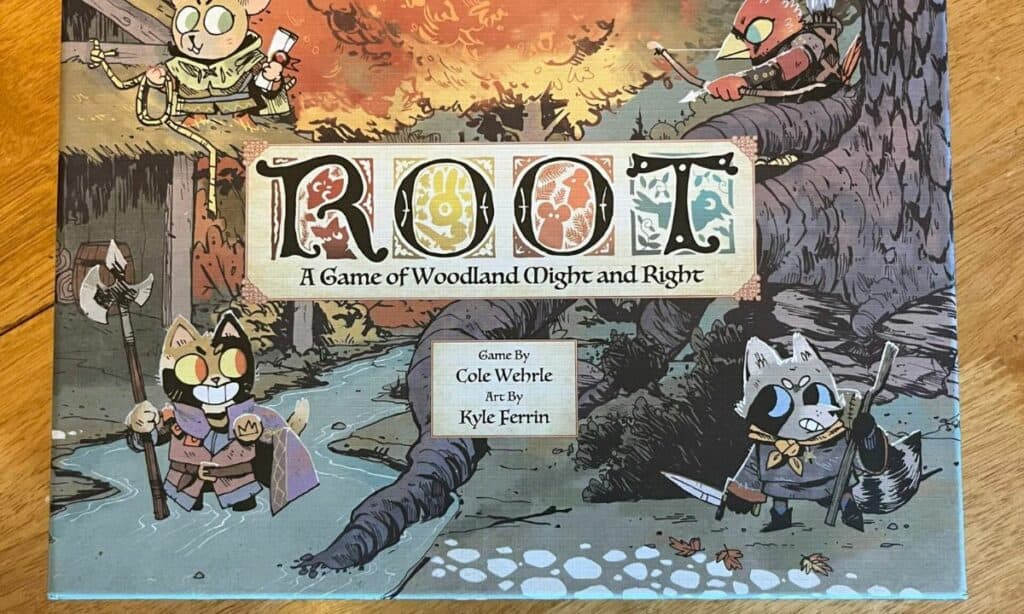From evil industrial capitalist cats to the rebellious Woodland Alliance, Root artfully brings together excellent worldbuilding with intriguing asynchronous play.
I have a soft spot for Root, largely driven by Kyle Ferrin’s fantastic and perfectly on-theme art. That said, Root is difficult to play, and asynchronous board games aren’t for everyone. Read on to find out how to play Root and for my full review of this paradoxically adorable wargame.
Everything You Need to Know About Root
- Number of players: 2-4
- Time to play: 60-90 minutes
- Age of players: 10+
- Designer: Cole Wehrle
- Publisher: Leder Games
Should you buy Root? Ask yourself the following:
- Do I like asynchronous board games (that is, board games where each player has a different mechanic or ruleset to follow)?
- Do I enjoy thematic, woodland-set games with cute animals?
- Do I like strategic wargames?
If your answer to all of the above is “yes”, then you should absolutely buy Root. That said, you don’t need to answer yes to every question to find something to love in this board game.
Root is a complex, highly strategic game that uses asynchronous player mechanics and has elements of wargames like Risk. It also has incredibly cute characters to play as in a well-designed thematic world as you fight each other in the forest amongst other animals for domination.
The blending of cute animal art and asynchronous play won me over, but some players find the mechanics tedious. I’ll dive more into why in my review below.
What’s Included in Root?
Maps and Boards
- A double-sided Main Board, one for a standard game and one for a ‘winter’ game
- Faction Mats for each of the base game factions
Cards
- A shared deck of cards with suits representing the different clearings (Fox, Rabbit, Mouse)
- Dominance cards
- Faction-specific cards
- Overview cards to help players understand the game mechanics and the special rules for each faction
Faction Pieces
- The Marquise de Cat’s buildings (Sawmills, Workshops, and Recruiters), wood tokens, and warriors
- The Eyrie Dynasties’ roosts and warriors
- The Woodland Alliance’s sympathy tokens, bases, and warriors
- The Vagabond’s pawn
- A score marker for each faction
Tokens
- Items (used by the Vagabond and found in ruins)
- Ruins tokens
- Clearing markers to help identify which faction rules a clearing
Dice: Two dice used for battling.
Books: A full rulebook (“The Law of Root”), a walkthrough sheet, and a “Learning to Play” guide.
How to Play Root
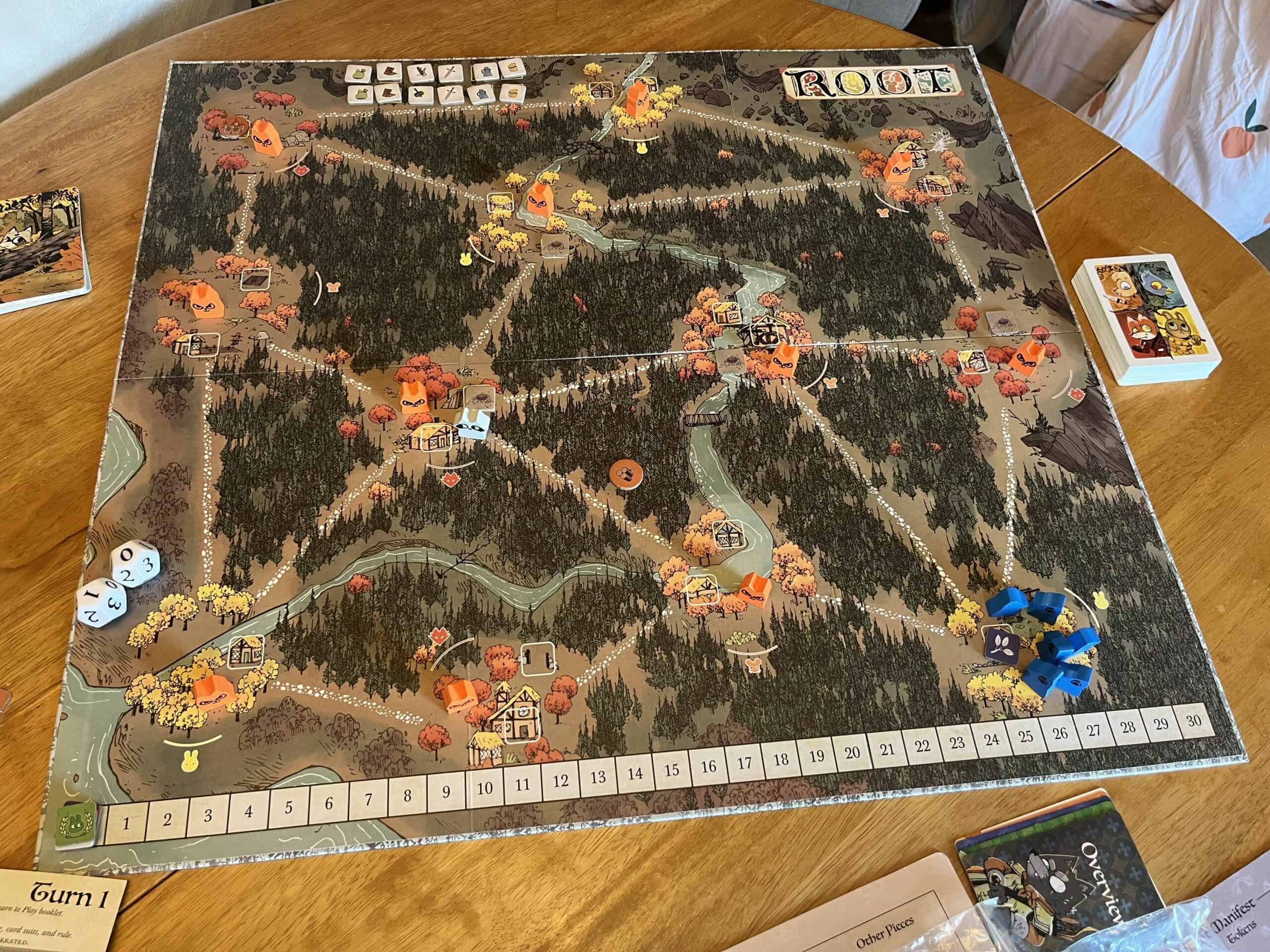
Setup
- Place the Board: Use the autumn side of the board normally. Experienced players might want to challenge themselves by playing with the winter side.
- Prepare the Deck: Shuffle the shared deck of cards and deal three to each player.
- Place the Tokens: Put the four ruins tokens in the matching spaces in the forest and place the items tokens in their corresponding spots on the top left of the board.
- Set up Factions: Each player chooses a faction and takes its corresponding components. Follow each faction’s specific setup instructions found on its player board.
How to Win Root
The aim of Root is to be the first to reach 30 victory points (VP). Once a player reaches this, they automatically win the game.
Alternatively, dominance cards can replace the standard 30 VP win. Players can choose to play a dominance card, which then sets out a new specific win condition based on control of the board. For example, a player with the ‘Mouse Dominance’ card wins immediately if they rule three clearings with the mouse symbol. Beforehand, that player must activate the dominance card during daylight, so other players can work to prevent them from winning this way.
Gameplay

Turn Structure
While each faction has a unique way of taking its turn, generally a turn is divided into three phases:
- Birdsong: This is often about setup, placing pieces, or making preparations.
- Daylight: Main actions like moving, battling, and crafting occur here.
- Evening: Concludes the turn, often drawing cards or scoring.
Daylight Actions
- Move: Move pieces from one clearing to another adjacent one.
- Battle: Resolve a conflict in a clearing where two opposing factions have pieces.
- Craft: Use the crafting pieces on the board to create items using cards from your hand, scoring points or gaining benefits.
Gameplay by Faction
Marquise de Cat
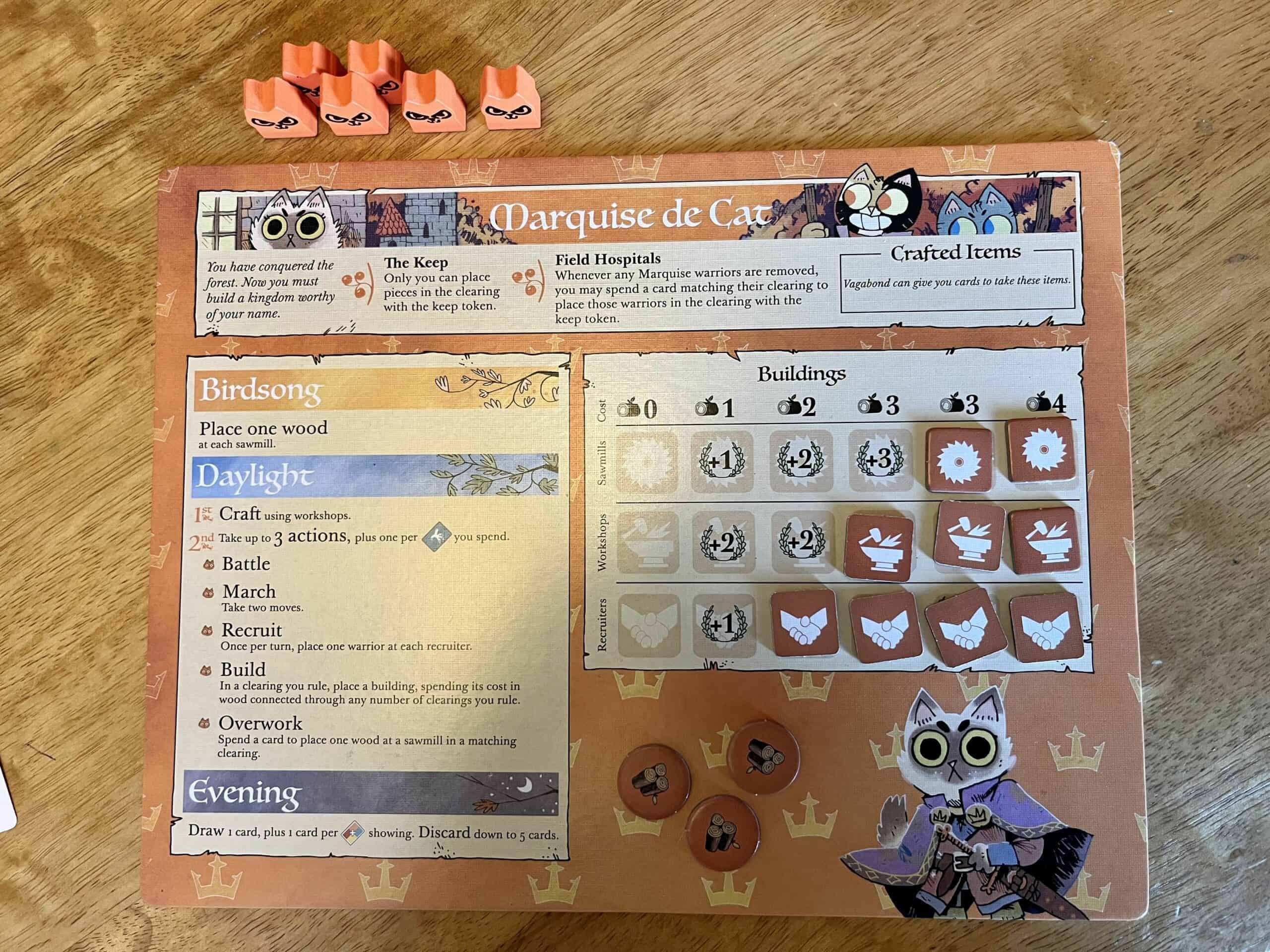
- Goal: Cover the forest in industrial structures to score points.
- Gameplay overview:
- Start with control of nearly all clearings.
- Gather wood from Sawmills to build more structures (Workshops, Sawmills, and Recruiting Stations).
- Score victory points by constructing buildings, scoring more points for having lots of the same building on the board.
Eyrie Dynasties

- Goal: Re-establish bird dominance in the forest by building roosts on the map, which scores points.
- Gameplay overview:
- Have a “Decree” which dictates specific actions you must take each turn (like recruiting or moving) and what clearings those actions can take place in.
- Add more orders to your decree each turn, forcing yourself to expand and engage in battles.
- If you can’t fulfil your decree, your government goes into “Turmoil”, which makes you lose points and re-establish your decree.
Woodland Alliance
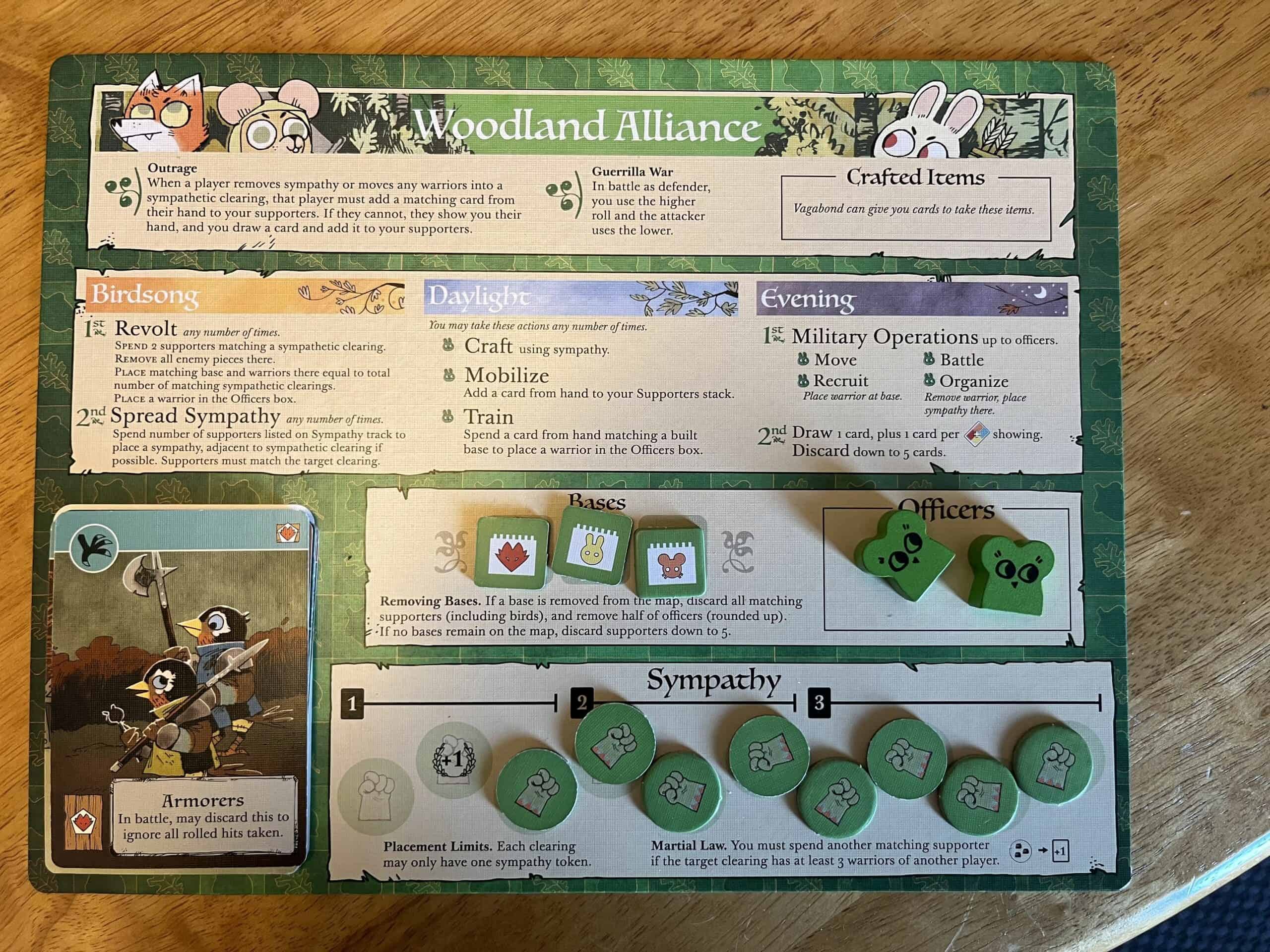
- Goal: Gain the sympathy of the wood by placing Sympathy tokens on the board, which score points.
- Gameplay overview:
- Add cards in your hand to your Supporters slot on your player mat.
- Play supporters from your mat to place Sympathy tokens in corresponding clearings.
- When you have two or more Sympathy tokens, it’s time to revolt: Remove all enemy pieces from the clearing, place a base in the clearing, and add warriors equal to the total number of bases on the map (from your supply) to the clearing.
Vagabond
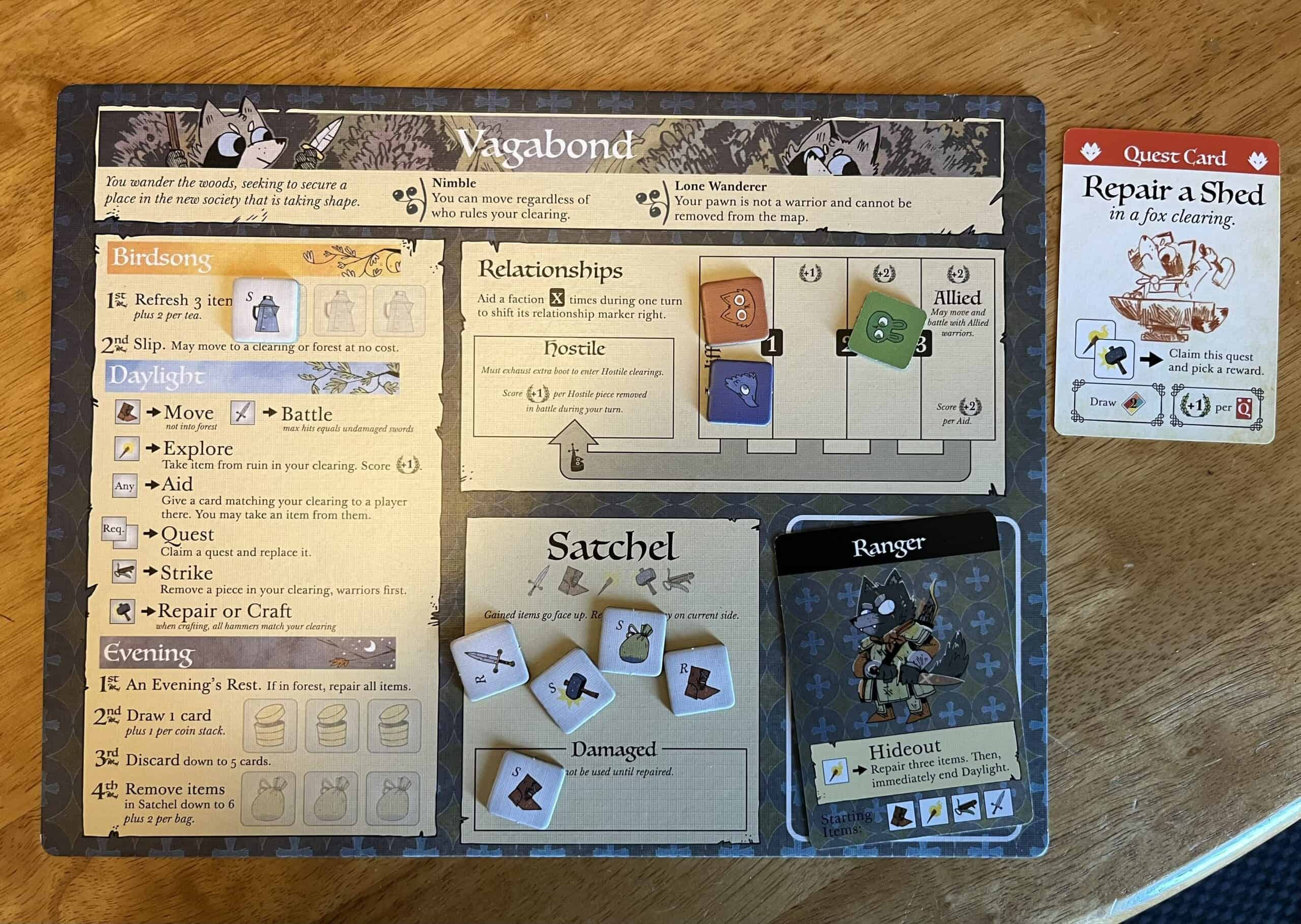
- Goal: Complete quest cards and aid factions in their movement and battles to score points.
- Gameplay overview:
- Exhaust item tokens (found underneath Ruins tokens) to move around the board, initiate and fight in battles, and aid allied factions.
- Create alliances with a faction and even make enemies with another — both score you points.
- Complete quest cards by being in the corresponding clearing and exhausting the items listed on the card.
My Review of Root
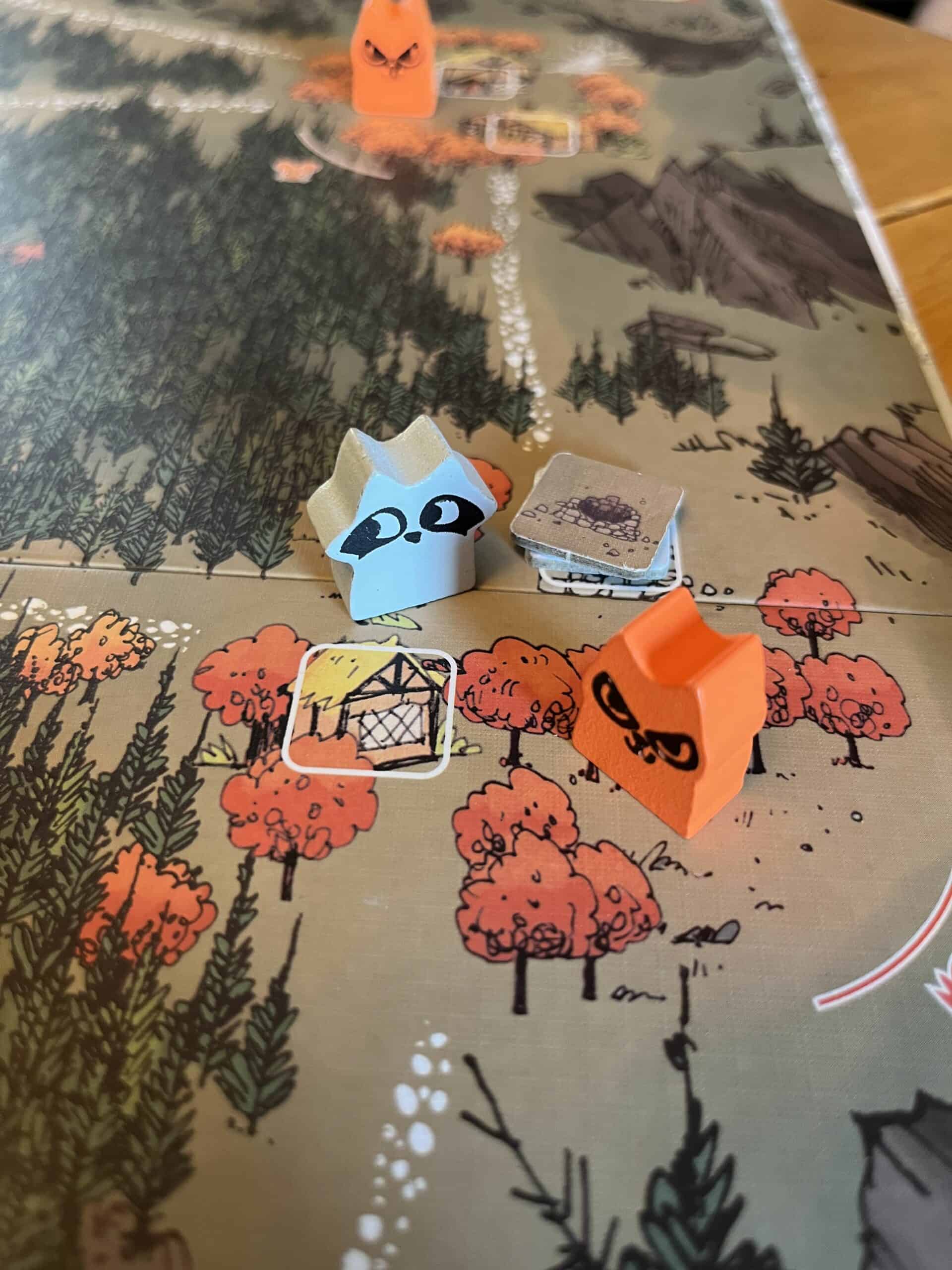
- Overall gameplay: 7/10
- Replayability: 6/10
- Artwork and components: 10/10
Pros
- Unique theme created with excellent artwork and worldbuilding
- Each faction is equally fun to play and creates a very different game for players
- Asynchronous play is unique and highly strategic
Cons
- Difficult to learn
- Limited replayability, especially for two players
- Mechanics can feel tedious or repetitive
- Overpowered Vagabond
As I mentioned in my introduction, I have a soft spot for Root thanks to Kyle Ferrin’s art and the overall worldbuilding, which the mechanics often complement thematically. The main battles of the forest are between the cats, birds, and woodland alliance (a collective of mice, rabbits, and foxes). These factions essentially act as industrial capitalists, dying out aristocrats honour-bound to their decrees, and upstarts rebels who can convince the woods to revolt against these warring elite factions. It may come as no surprise that there’s now a Root roleplaying game.
Root’s art really brings the game’s theme together. Cute animals in military garb in an autumnal forest full of old ruins and a conniving badger give Root a Narnia-esque feel. The art and theme are one of the main attractions of this game, so if cutesy animal games like Everdell and The Isle of Cats are your thing, it’s well worth giving Root a try.
Let’s move on to gameplay. Root is an excellent strategy game in many ways. Its use of asynchronous play is what really sets it apart from other war and strategy games (like Risk). Experienced board gamers will find the nuances of each faction’s gameplay intriguing and rewarding — especially, in my opinion, the Eyrie Dynasties. The honour-bound birds of the forest have a decree system that requires constant balancing and ensuring that you go into Turmoil at just the right moments. They’re not easy to play as but when it goes right the points rain and it’s incredibly satisfying.
That said, the gameplay is difficult. Root comes with a ‘learn-to-play’ walkthrough sheet, which is essential for any first game or the introduction of a newbie player. Asynchronous playing means you can’t learn from other players as you go. The Woodland Alliance is especially difficult to take on as a new player and can become frustrating quickly.
Asynchronous play isn’t for everyone, and while I’ve always enjoyed the careful mechanics of Root, I’ve had plenty of players find them tedious and repetitive at times.
Root shuffled off our regular games shelf for another reason. I usually play with just one other gamer (big board game groups are a rare treat). While you can play with any combination of factions (and adding the Riverfolk expansion helped here), gameplay can get repetitive and isn’t as dynamic with just two players. In terms of replayability, once you’ve tried out all the factions with your gaming friends, Root is more likely to be occasional fun than a table staple.
My final problem with Root is the Vagabond. While making alliances is the suggested point-scoring mechanic for the Vagabond, he can easily avoid conflicts entirely by focusing on Quest Cards. These rack up points quickly and make for an easy win, so I often find this character too OP.
Criticisms aside, Root is a wonderful game. Not for the most casual gamers, but certainly for committed board gamers who enjoy strategy and an excellent theme.
Root Expansions: A Mini Guide
The Riverfolk Expansion
New Factions
- The Riverfolk Company: A mercantile faction that sells services to other players, including mercenaries, cards, and river transport. They earn points by accumulating wealth.
- The Lizard Cult: Religious zealots who turn lost souls into fervent followers. They score by building gardens and spreading their faith.
Other Components: A new Vagabond character and additional cards. Increases player count to 6.
Mini Review: If you buy one Root expansion, it should be the Riverfolk expansion. This expansion adds a lot of player interaction to the game, especially when using the Riverfolk Company. The Lizard Cult offers a fun challenge too and can keep other players on their toes. However, some players find the Lizard Cult difficult to grasp or win with and the Riverfolk Company’s success can depend a lot on other players’ engagement.
The Underworld Expansion
New Factions
- The Underground Duchy: Moles that can rapidly spread across the board and have a versatile action selection system. They build buildings and recruit ministers for points and actions.
- The Corvid Conspiracy: Sneaky crows that use plotting and subterfuge to spread mischief and lay traps for other factions.
Other Components: A double-sided board with two new maps: Mountain and Lake.
Mini Review: The expansion offers significant variety for fans of Root, with the moles appealing to any strategically-minded player, while the crows introduce a bluffing element to the game. The new maps are a welcome change of scenery and offer fresh strategic considerations.
The Clockwork Expansion
Components: This expansion offers automated versions of the base factions — the Mechanical Marquise, the Electric Eyrie, the Automated Alliance, and the Vagabot. This allows you to play Root solo or add an automated faction to a game with fewer players.
Mini Review: The Clockwork Expansion meets the need of those who want to play Root solo or spice up games with fewer players, which certainly helps with my criticism about Root’s replayability with just two players. While the bots can’t replicate human strategy perfectly, they do offer a competent and challenging alternative.
The Exiles and Partisans Deck
Components: A new shared deck of cards that can replace the base deck, introducing different card abilities and crafting options.
Mini Review: This isn’t a full-fledged expansion like the others, but it does offer a fresh twist on gameplay. These cards add new ways to gain points, craft items, and win in battles and add a lot of variety to the existing game. I would say that Exiles and Partisans is an essential mini-expansion that anyone who enjoys Root should pick up and add to their regular games.
Conclusion
With a rich world of warring animals and perfectly on-theme expansions, Root can certainly become your next favourite board game. It’s hard work at times and might baffle new players a little, but its difficulty level is easily balanced out by its rewarding strategic mechanics and cute art.
If you enjoy strategy games, Root is an essential addition to your collection. It’s been a moment since it hit the table at my game nights, but writing this review and unpacking the game again reminded me how fun Root is and how much I love the world it creates.
Frequently Asked Questions
Question: Is Root difficult to play?
Answer: Yes, Root is certainly a difficult game to learn, though once you’ve picked up the mechanics of any given faction, you’ll quickly get the hang of it. Newbie gamers may struggle the most since its asynchronous style makes it harder to learn from other players as you go.
Question: Is Root good for two players?
Answer: While Root is perfectly playable for two players, replayability and the overall strategic fun of the game is limited. If you regularly play with just one other person, I would recommend picking up the Clockwork expansion to add automated factions to the game.
Question: Can you play Root alone?
Answer: With the Clockwork expansion, you can play Root in solo mode.
Find more fun games and how to play them here:
Gloomhaven Board Game Guide and Review
Best Ticket to Ride Games Ranked
Terraforming Mars Guide: Fighting for Spaces in Space
- Everdell Board Game Guide and Review - August 30, 2023
- Root Board Game Guide and Review - August 17, 2023
- Gloomhaven Board Game Guide and Review - August 16, 2023

